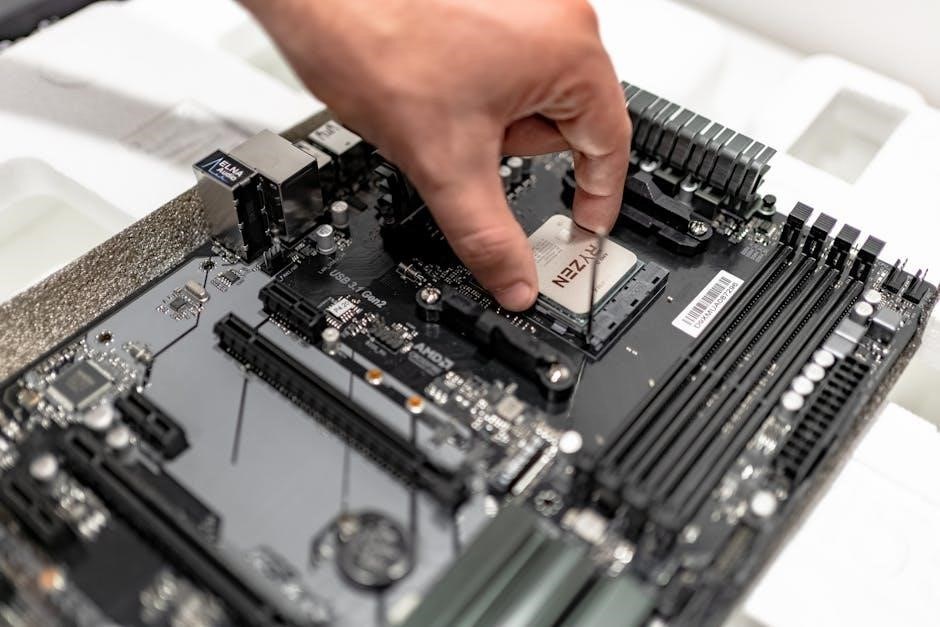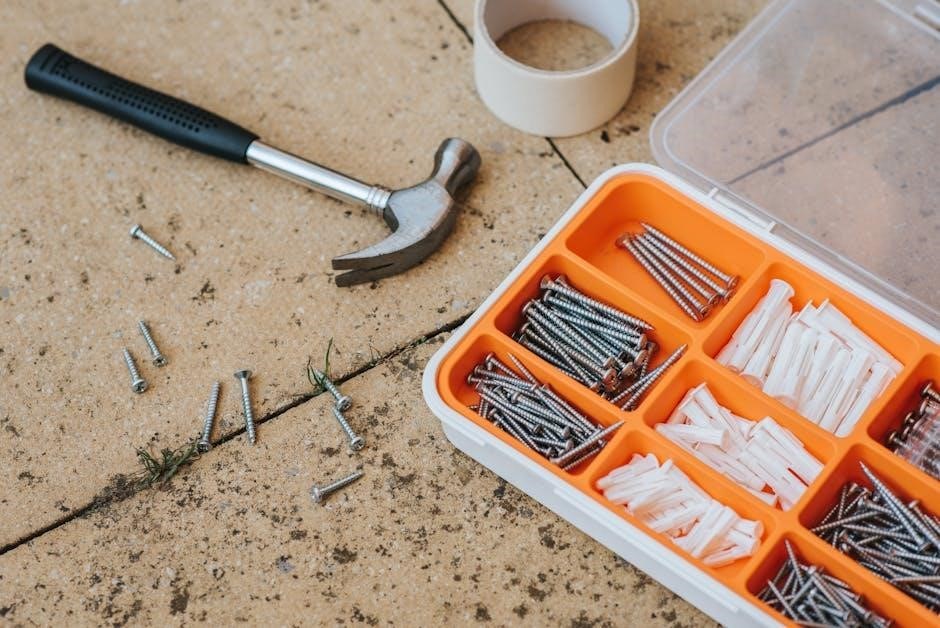Welcome to the Remington 870 User Manual. This guide provides essential information for safe and effective use of your shotgun. Read carefully to ensure proper handling and maintenance. Understand safety precautions, loading, firing, and care procedures. This manual is your key to responsible ownership and optimal performance.
1.1 Purpose of the Manual
The purpose of this manual is to provide Remington 870 users with comprehensive guidance on safe handling, operation, and maintenance. It ensures owners understand proper techniques, safety protocols, and care procedures. This guide covers essential topics such as loading, firing, and storage, while emphasizing responsible ownership. By following the instructions, users can maximize the shotgun’s performance and lifespan. The manual serves as a critical resource for both experienced shooters and newcomers, promoting confidence and adherence to firearms safety standards. It is designed to accompany the firearm at all times, ensuring safe and effective use.
1.2 Importance of Reading the Manual
Reading the Remington 870 user manual is crucial for safe and effective use of the shotgun. It provides detailed instructions on handling, loading, and firing, ensuring users understand proper techniques. The manual highlights safety precautions to prevent accidents and injuries. By familiarizing yourself with the shotgun’s features and maintenance requirements, you can extend its lifespan and optimize performance. Understanding the manual also helps comply with legal and ethical standards for firearm ownership. It serves as a vital reference for troubleshooting and responsible ownership, making it essential for both novice and experienced users to read and follow its guidelines carefully.
1.3 Safety Precautions
The Remington 870 user manual emphasizes critical safety precautions to ensure safe handling and operation. Always treat the shotgun as loaded, keep the muzzle pointed in a safe direction, and avoid touching the trigger until ready to shoot. Use appropriate ammunition and ensure the shotgun is properly assembled. Never modify the firearm or bypass safety mechanisms. Regular inspection and maintenance are essential to prevent malfunctions. Failure to follow these guidelines can result in accidental discharge, injury, or death. Adhering to these precautions ensures a safe, responsible, and enjoyable shooting experience.

Understanding the Remington 870 Shotgun
The Remington 870 is a pump-action shotgun renowned for its reliability and durability. Introduced in 1950, it remains a popular choice for hunting, home defense, and sport shooting.
2.1 Overview of the Shotgun
The Remington 870 is a pump-action shotgun designed for versatility and reliability. Manufactured by Remington Arms Company, it has been a trusted firearm since its introduction in 1950. Known for its durable construction and smooth operation, the 870 is widely used for hunting, sport shooting, and home defense. Its pump-action design allows for consistent reloading and minimal recoil, making it accessible to both novice and experienced shooters.
Available in various gauges and barrel lengths, the Remington 870 adapts to multiple shooting needs, ensuring it remains a popular choice for enthusiasts and professionals alike.
2.2 Key Features and Design
The Remington 870 features a robust pump-action design, ensuring reliable operation in various conditions. Its tubular magazine holds up to 4+1 shells, depending on the model. The shotgun is available in 12, 16, 20, 28 gauges, and .410 bore, offering versatility for different shooting needs. The receiver is made of durable steel, while the barrel and action are built for longevity. Its interchangeable barrels and choke systems allow customization for hunting, sport shooting, or home defense. The 870’s simplicity and reliability have made it a favorite among shooters for decades.
2.3 Historical Background
The Remington 870 was introduced in 1950, quickly becoming a legendary firearm. Designed by L. Ray Crittendon, it replaced the Model 31 and featured a sleek, pump-action design. Initially marketed for hunting and sport shooting, it gained popularity in law enforcement and military circles. Its durability and reliability made it a favorite worldwide. Over the decades, the 870 has evolved with various models, including the Express, Wingmaster, and Tactical. Its timeless design has solidified its place as one of the most iconic shotguns in history, with millions produced and used globally for both professional and recreational purposes.

Safety Guidelines
Always prioritize safety when handling the Remington 870. Follow all safety guidelines, including proper handling, storage, and adhering to warning labels. Ensure safe operation at all times.
3.1 General Safety Rules
Always treat the shotgun as loaded and keep the muzzle pointed away from people. Never handle the firearm while under the influence of alcohol or drugs. Ensure the barrel is clear of obstructions before firing. Keep fingers outside the trigger guard until ready to shoot. Store the shotgun unloaded in a secure location, out of reach of children. Wear eye and ear protection when firing. Follow all local laws and regulations. These rules are essential for safe operation and responsible ownership of the Remington 870.
3.2 Safe Handling and Storage
Always handle the Remington 870 with care, ensuring the muzzle points in a safe direction. Store the shotgun unloaded, with the action open, in a secure location. Use a gun safe or lockbox to prevent unauthorized access. Keep ammunition stored separately from the firearm. Avoid exposing the shotgun to extreme temperatures or moisture. Regularly inspect the storage area for potential hazards. Never store the Remington 870 in a fully assembled state. Use a trigger lock for added security. Proper storage ensures safety and maintains the firearm’s condition.
3.3 Warning Labels and Instructions
Warning labels on the Remington 870 are critical for safe operation. They highlight potential hazards and provide clear instructions to avoid accidents. Always read and adhere to these warnings before handling the firearm. Labels emphasize keeping the shotgun out of reach of children and unauthorized users. Never modify the firearm without authorization, as this can void warranties and create safety risks. Failure to follow instructions may result in injury or death. Heed all safety advisories to ensure responsible and secure use of the Remington 870 shotgun.

Operating the Remington 870
Mastering the operation of the Remington 870 ensures safe and effective use. Follow proper loading, unloading, and firing techniques outlined in this section for optimal performance and safety.
4.1 Loading the Shotgun
Always ensure the shotgun is unloaded before loading. Inspect the chamber and magazine tube to confirm they are empty. Use 2.75″ or 3″ shells, depending on your model. Open the action by pumping the fore-end. Align the shell with the magazine tube, ensuring it clicks into place. Repeat until the magazine is full. Close the action smoothly and engage the safety. Never load more than the recommended capacity. Always follow safety guidelines and verify the shotgun is unloaded when not in use. Proper loading ensures reliability and safety.

4.2 Unloading the Shotgun
Unloading the Remington 870 is a critical process for safety. Always ensure the safety is engaged before starting. Pump the fore-end to eject any shell from the chamber. Open the action and visually inspect the chamber and magazine tube to confirm they are empty. Remove any remaining shells from the magazine tube. Never assume the shotgun is unloaded without verification. Always treat the firearm as loaded until you have confirmed it is empty. Follow these steps carefully to ensure safe handling and storage of your shotgun.
4.3 Firing the Shotgun
Before firing, ensure the shotgun is properly loaded and the safety is disengaged. Always point the muzzle in a safe direction. Shoulder the shotgun firmly, align the sights with your target, and squeeze the trigger smoothly. After firing, keep the muzzle downrange and the action closed until ready to reload or unload. Always follow safety guidelines and use common sense to avoid accidents. Proper firing technique ensures accuracy and control. Remember to stay focused and maintain control of the firearm at all times during operation.
Maintenance and Care
Regular maintenance ensures optimal performance and longevity of your Remington 870. Clean the shotgun thoroughly after use, lubricate moving parts, and inspect for wear or damage regularly.
5.1 Cleaning the Shotgun
Cleaning the Remington 870 is crucial for maintaining reliability and performance. Start by disassembling the shotgun, removing the barrel and forearm. Use a cleaning rod and brush to scrub the barrel, chamber, and receiver. Pay special attention to the bolt and action areas, ensuring no residue remains. Wipe down all surfaces with a clean, dry cloth. Lightly lubricate moving parts as specified in the manual. Regular cleaning prevents corrosion and ensures smooth operation. Always follow the manual’s guidelines for proper cleaning techniques and safety precautions.
5.2 Lubrication and Maintenance

Proper lubrication is essential for the smooth operation of your Remington 870. Apply a high-quality gun oil to moving parts, such as the action, bolt, and pump. Avoid over-lubrication, as it can attract dirt and debris. Regularly inspect the shotgun for wear and tear, replacing worn parts as needed. Lubricate after cleaning or extended storage to prevent corrosion. Follow the manual’s recommendations for specific lubrication points and frequencies. Consistent maintenance ensures reliability and extends the shotgun’s lifespan, keeping it in optimal condition for years of use.
5.3 Inspection and Repair

Regular inspection of your Remington 870 is crucial for maintaining its performance and safety. Check for wear, damage, or corrosion on all components, including the barrel, action, and stock. Ensure all parts function smoothly and are properly aligned. If you find damage or excessive wear, address it promptly. Minor repairs, like replacing worn springs or cleaning fouled areas, can be done with basic tools. For major issues, consult a professional gunsmith to avoid further damage. Always follow the manual’s repair guidelines to ensure reliability and safety. Regular inspections prevent malfunctions and extend the shotgun’s service life.
Accessories and Customization
Explore a wide range of accessories and customization options for your Remington 870. Enhance functionality with scopes, slings, and tactical upgrades. Personalize your shotgun to fit your needs.
6.1 Available Accessories
The Remington 870 offers a wide range of accessories to enhance its performance and customization. These include high-quality scopes, durable slings, and tactical upgrades for improved functionality. Stocks, grips, and magazine extensions are popular choices for personalization. Additionally, lighting and optics can be added for better visibility in low-light conditions. Accessories like choke tubes and barrel extensions further tailor the shotgun to specific uses, such as hunting or home defense. Explore the official Remington catalog or trusted retailers for genuine and compatible parts to maximize your shotgun’s potential.
6.2 Customizing the Shotgun
Customizing the Remington 870 allows users to tailor the shotgun to their preferences and needs; Common modifications include upgrading stocks, grips, and finishes for improved ergonomics and aesthetics. Tactical rails and attachments can enhance functionality for specific uses. Many enthusiasts also opt for custom engravings or unique barrel configurations. Additionally, aftermarket parts like triggers and sights can be installed to refine performance. Always ensure that modifications comply with local laws and regulations. Customization enhances both functionality and personal style, making the Remington 870 truly versatile for its owner.
6.3 Upgrading Parts

Upgrading parts on the Remington 870 can enhance performance and tailor the shotgun to specific needs. Common upgrades include stocks, barrels, and triggers for improved ergonomics and accuracy. Tactical rails and attachments, such as scopes or lights, are popular for versatility. Ensure all modifications are compatible with the shotgun’s design and comply with local laws. Always follow the manufacturer’s guidelines or consult a professional for complex upgrades. Proper installation is crucial to maintain safety and functionality. Upgrading parts can extend the shotgun’s lifespan and adapt it to various shooting scenarios, ensuring optimal performance for years to come.
Troubleshooting Common Issues
Identify and resolve common issues like failure to feed, ejecting problems, or jamming. Check ammunition quality, ensure proper maintenance, and clean regularly. Consult the manual or a professional if issues persist.
7.1 Identifying Common Problems
Common issues with the Remington 870 include failure to feed, ejecting problems, and jamming. These often result from poor ammunition quality, improper cleaning, or worn parts. Users may also experience misfires or inconsistent firing patterns. To identify problems, inspect the shotgun’s action, magazine tube, and barrel for obstructions or damage. Consult the manual for troubleshooting steps and ensure all maintenance routines are followed. If issues persist, seek professional assistance to avoid further damage or safety risks.
7.2 Resolving Malfunctions
To resolve malfunctions with the Remington 870, start by ensuring the shotgun is unloaded. Check for obstructions in the barrel, chamber, or magazine tube. Clean the action and lubricate moving parts if sticking occurs. Inspect the extractor and ejector for wear or damage and replace if necessary. Verify proper ammunition quality and ensure the shotgun is assembled correctly. If issues persist, consult a professional gunsmith. Always follow safety guidelines and the manual’s instructions to prevent further damage or safety risks.
7.3 When to Seek Professional Help
If malfunctions persist despite troubleshooting, seek professional help. Contact a certified gunsmith or Remington-authorized service center for complex repairs. Issues like a cracked barrel, faulty extractor, or recurring jams require expert attention. Do not attempt repairs beyond your skill level, as this could worsen the problem or compromise safety. Always prioritize firearm safety and reliability by consulting professionals for unresolved issues. This ensures your Remington 870 operates correctly and remains a reliable tool for years to come.
Legal and Ethical Considerations
Adhere to all firearm laws and regulations. Ethical use ensures responsible ownership and respect for safety. Always comply with legal requirements and practice ethical shotgun handling.
8.1 Firearms Laws and Regulations
Firearms laws and regulations vary by jurisdiction. Ensure compliance with local, state, and federal laws. Licensing, permits, and age restrictions apply. Background checks and prohibited persons laws are enforced. Safe storage requirements must be followed. Violations can result in legal penalties. Stay informed about updates to firearm regulations. Ethical responsibility includes adhering to these laws and using the Remington 870 legally and respectfully. Always verify legal requirements before purchasing, owning, or using the shotgun. Compliance ensures public safety and responsible firearm ownership.

8.2 Ethical Use of the Shotgun
Ethical use of the Remington 870 involves responsible handling and respect for human life. Always prioritize safety and avoid misuse. Use the shotgun only for lawful purposes, such as hunting or self-defense. Respect wildlife and the environment when hunting. Avoid reckless behavior that could endanger others. Ethical ownership includes proper storage to prevent unauthorized access. Promote firearm safety through education and example. Misuse can lead to tragic consequences, so handle the shotgun with care and mindfulness. Ethical use ensures the shotgun serves its intended purpose responsibly and respectfully.

8.3 Responsible Ownership
Responsible ownership of the Remington 870 involves adhering to all local, state, and federal firearms laws. Always store the shotgun securely to prevent unauthorized access, especially by children. Regular maintenance ensures reliability and safety. Stay informed about legal requirements and best practices for firearm ownership. Engage in proper training to handle the shotgun confidently and safely. Responsible ownership also includes respecting the intended use of the firearm and avoiding reckless or negligent behavior. By following these guidelines, you contribute to a culture of safety and accountability in firearm ownership.
In conclusion, the Remington 870 user manual guides you in safe handling, maintenance, and responsible ownership. Always follow safety protocols and practice proper techniques.
9.1 Final Thoughts
9.2 Encouragement to Practice Safe Handling
Safe handling of the Remington 870 is critical to prevent accidents and ensure responsible use. Always follow the safety guidelines outlined in this manual, such as keeping the muzzle pointed in a safe direction and avoiding finger contact with the trigger until ready to shoot. Negligent handling can lead to severe consequences. As a firearm owner, it is your duty to prioritize safety, not only for yourself but also for others. Regular practice and review of safety protocols will build confidence and reinforce responsible ownership. Remember, safety is everyone’s responsibility.













































